| Skip Navigation Links | |
| Exit Print View | |

|
Master Index Data Manager User's Guide Java CAPS Documentation |
| Skip Navigation Links | |
| Exit Print View | |

|
Master Index Data Manager User's Guide Java CAPS Documentation |
Master Index Data Manager User's Guide
About the Master Index Data Manager
About Oracle Java CAPS Master Index
About Master Index Applications
Features of Master Index Applications
Functions of the Master Index Data Manager
Learning about MIDM Object Profiles
MIDM Object Profile Components
Source Record and SBR Components in a Master Index
Identification Numbers for each Entity in the Master Index
Working with the Master Index Data Manager
Logging in to the Master Index Data Manager
Master Index Data Manager Security Permissions
Master Index Data Manager Navigation Tips
Navigating the MIDM Detail Pages
Viewing Summary Information From the Dashboard
Accessing Reports and Audit Logs From the Dashboard
To Access Reports and Audit Logs From the Dashboard
Performing a Quick Search (EUID Lookup)
Performing an EUID Comparison Lookup
To Perform an EUID Comparison Lookup
Learning About Object Queries on the MIDM
About the MIDM Search Function
Searching by Ranges on the MIDM
Searching for Object Profiles on the MIDM
Performing an Alphanumeric Search
To Perform an Alphanumeric Search
Performing an EUID Comparison Lookup
To Perform an EUID Comparison Lookup
Working with Search Results on the MIDM
Viewing the Results of a Search
Selecting a Profile from the Results List
Sorting the Results of Your Search
Learning About Object Profile Views on the MIDM
Object Profile Details on the MIDM
Source Record Details on the MIDM
Object Profile and Source Record Comparisons
Object Profile Transaction Histories
Object Profile Merge Histories on the MIDM
Viewing Object Information on the MIDM
Viewing Object Profiles on the MIDM
Viewing a Source Record on the MIDM
Comparing Object Information on the MIDM
Comparing Two or More Object Profiles
Comparing Source Records From Object Profile Views
Comparing Source Records From One Source System
Viewing Transaction Histories on the MIDM
To View a Complete Transaction History For an Object Profile
To View Transaction History Records from the Transactions Page
About Transaction History Search Fields on the MIDM
About Transaction History Results Fields on the MIDM
Transaction History Transaction Types on the MIDM
Viewing a Profile's Merge History on the MIDM
To View an Object's Merge History
Viewing Merged Profiles for an Object Profile
To View Merged Profiles for an Object Profile
About Audit Log Search Fields on the MIDM
About Audit Log Results Fields on the MIDM
Audit Log Functions on the MIDM
Adding an Object Profile on the MIDM
Step 1: Obtain Information about the Object
Step 2: Specify a System and Local ID
To Specify a System and Local ID
Step 3: Specify Parent Object Information
To Specify Parent Object Information
Step 4: Specify Child Object Information
To Specify Child Object Information
Step 5: Save the Object Profile
Learning About MIDM Maintenance Tasks
Surviving and Non-Surviving Profiles
Handling Potential Duplicates on the MIDM
Linking Source Record Fields to the SBR
Locking Field Values in the SBR
Modifying Profile Information on the MIDM
Modifying Information in an Object Profile
Modifying Parent Object Information in a Profile
Adding a Child Object to an Object Profile
Modifying a Child Object in a Profile
Deleting a Child Object From a Profile
Modifying Information Directly in a Source Record
Modifying the Parent Object in a Source Record
Adding a Child Object to a Source Record
Modifying a Child Object in a Source Record
Deleting a Child Object From a Source Record
Overriding the Survivor Calculator's SBR
Linking an SBR Field to a Specific Source Record
Unlinking an SBR Field From a Source Record
Adding a Source Record to an Object Profile
To Add a Source Record to an Object Profile
Deactivating a Profile or Source Record
Deactivating an Object Profile
Reactivating a Profile or Source Record
Working with Potential Duplicate Profiles on the MIDM
Finding Potential Duplicate Profiles on the MIDM
About Duplicate Records Search Fields on the MIDM
Merging Potential Duplicate Profiles
To Combine Duplicate Profiles From the Comparison Page
Resolving Potential Duplicate Profiles on the MIDM
To Resolve Potential Duplicate Profiles From the Results List
To Resolve Potential Duplicate Profiles From the Comparison Page
Unresolving Potential Duplicate Profiles on the MIDM
To Unresolve Potential Duplicate Profiles From the Results List
To Unresolve Potential Duplicate Profiles From the Comparison Page
Working with Assumed Matches on the MIDM
Finding Assumed Matches on the MIDM
About Assumed Matches Search Fields
About Assumed Match Results Fields on the MIDM
Reversing an Assumed Match on the MIDM
Combining Object Information on the MIDM
Merging Object Profiles on the MIDM
Merging Source Records on the MIDM
Unmerging Object Information on the MIDM
Unmerging Object Profiles on the MIDM
Unmerging Source Records on the MIDM
Once an object profile has been added to the master index application, you can modify information about that object, update the object's single best record, add source records to the profile, or change the status of a source record or object profile. If you make any of these modifications, the survivor calculator determines what changes, if any, should be made to the SBR. You can only modify the SBR directly if you have access permission to do so.
Perform any of the following tasks to update profile information:
If the information for an object profile changes, you can update the information in either the SBR or the affected source record. If you update the source record, then the survivor calculator determines what changes, if any, should be made to the SBR. You must have overwrite permissions to update the SBR directly. If you know the local ID and system of the source record you want to modify, you can access the source record directly, as described in Modifying Information Directly in a Source Record.
Perform any of the following tasks to modify information in an object profile:
The Record Details page has an edit mode, where you can modify field values in the displayed object profile. The following figure shows the Record Details page in edit mode.
Figure 32 Record Detail Page - Parent Object
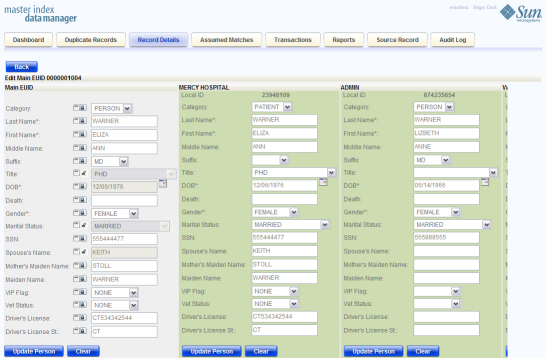
Note - You can only modify SBR fields directly if you have permissions to do so.
The page refreshes, and, if you modified a source record, the SBR is recalculated based on the new information.
If additional information becomes available about an object, you might need to add a new child object to the object profile. For example, if additional address information becomes available, you might need to add a new address record to the affected source record. You cannot add a child object to the SBR.
Figure 33 Record Details Page - Child Objects

For example, to add an address record, select View Addresses.
The page refreshes and the SBR is recalculated based on the new information.
If information about a child object changes, you might need to modify information for an existing child object. You cannot modify information in child object in the SBR. The following figure shows a child object on the Record Details page in edit mode.
Figure 34 Record Details Page – Edit Child Object

Empty child object fields appear along with a list of existing child objects of the selected type.
The field values for the selected child object are populated into the child object fields.
The page refreshes, and, if you modified a source record, the SBR is recalculated based on the new information.
If a child object is entered incorrectly or becomes obsolete, you can delete the object from the affected object profile. Child objects cannot be deleted from the SBR. Deleting a child object cannot be undone.
Figure 35 Record Details Page – Delete Child Object
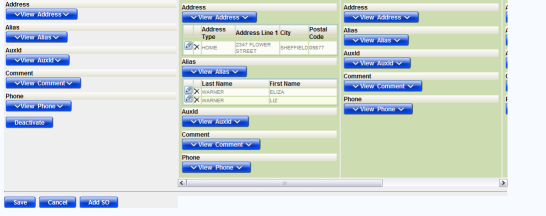
Empty child object fields appear along with a list of existing child objects of the selected type.
The delete icon is shaped like an “X”.
The page refreshes, and, if you modified a source record, the SBR is recalculated based on the new information.
If the object information for a specific source record changes, you can update the information by accessing either the object profile or the affected source record. If you update the source record, then the survivor calculator determines what changes, if any, should be made to the SBR. This section describes how to modify information by accessing the source record directly. For information about modifying an object profile, see Modifying Information in an Object Profile.
Perform any of the following tasks to modify information in a source record directly:
If parent object for a particular source record changes, you can update the source record directly on the Source Record page. The following figure shows the Source Record page in edit mode.
Figure 36 Source Record Page – Edit Parent Object
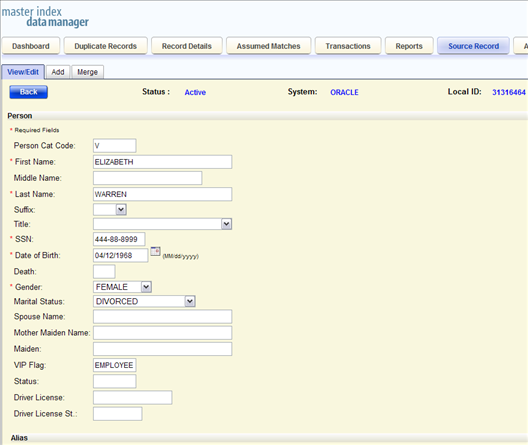
If a matching source record is found, it appears on the Source Record page in view mode.
The page refreshes, and, if you modified a source record, the SBR is recalculated based on the new information.
If additional information becomes available about an object, you might need to add a new child object to a source record. For example, if additional address information becomes available, you might need to add a new address record to the affected source record.
Figure 37 Source Record Page - Add Child Object

If a matching source record is found, it appears on the Source Record page in view mode.
The child object section expands to display empty fields for the object.
The page refreshes, and, if you modified a source record, the SBR is recalculated based on the new information.
If information about an object changes, you might need to modify information for an existing child object. You can make those changes on the Source Record page.
Figure 38 Source Record Page – Edit Child Object
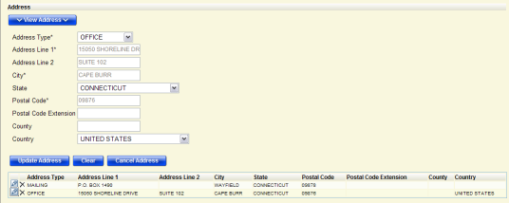
If a matching record is found, it appears on the Source Record page in view mode.
The child object section expands to display empty fields for the object along with a list of existing child objects.
The child object fields are populated with the values from the child object you selected.
The page refreshes, and, if you modified a source record, the SBR is recalculated based on the new information.
If a child object is entered incorrectly or becomes obsolete, you can delete the object from the affected source record. Deleting a child object cannot be undone.
Figure 39 Source Record Page – Delete Child Object

If a matching record is found, it appears on the Source Record page in view mode.
The child object section expands to display a list of existing child objects.
The delete icon looks like an “X”.
The page refreshes, and the SBR of the object profile is recalculated based on the new information.
Locking an SBR field for overwrite is one way to ensure that the value for that field is not recalculated by the survivor calculator each time the object profile is updated. If you determine that a value in the SBR is the most accurate data and should not be updated, you can lock the field and no updates can be made to that SBR field by the survivor calculator until it is unlocked. If you unlock a locked field, the value of that field is automatically recalculated by the survivor calculator as soon as the unlock action is committed. Only parent object fields can be locked.
When you lock a field in an SBR, that field can only be updated through the MIDM by a user who has overwrite permissions. Locking a field in the SBR removes the survivor calculator from the update process for that field and any updates made to or by source records will not update the locked fields in the SBR. You can only lock fields in the parent object.
The following figure shows an object profile with three locked fields in the SBR (as indicated by the open padlock icons in the column beneath the red arrow).
Figure 40 Locked Fields in an SBR Indicated by Open Padlocks
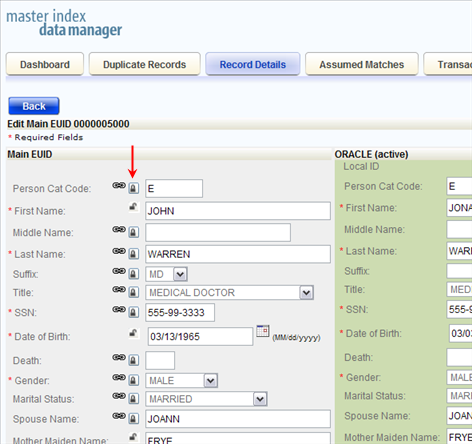
Note - A closed padlock indicates an unlocked field that can be locked. An open padlock indicates a locked field that can be unlocked.
The field is now locked and cannot be edited by updates to source records until the lock is removed. The link icon is also removed since a locked field cannot be linked to a source record field.
Once you unlock a field for overwrite in an SBR, the SBR is recalculated by the survivor calculator and the field can be updated by changes made to source records. The following figure shows an object profile in edit mode with all fields unlocked (as indicated by the column of icons below the red arrow).
Figure 41 Unlocked Fields in an SBR as Indicated by Closed Padlocks

Note - A closed padlock indicates an unlocked field that can be locked. An open padlock indicates a locked field that can be unlocked.
The field is now unlocked and can be edited by updates to source records. The link icon appears next to the field again because the field can now be linked to a source record field.
Linking an SBR field to a field in a source record is one way to ensure that the value for that field is not recalculated by the survivor calculator each time the object profile is updated. If you determine that a value in a specific source system is the most accurate data and should always be used in the SBR, you can link the field values and override the survivor calculator's version of the SBR. If you unlink a linked field, the value of that field is automatically recalculated by the survivor calculator as soon as the unlink action is performed. You can only link field values from the parent object.
When you link a field in an SBR to a field in one of the profile's source records, the value of the field will always equal the value of the field in the source record, even when the source record field is updated. Linking a field in the SBR to a source record removes the survivor calculator from the update process for that field. Any updates made to or by other source records in the profile will not update the linked field in the SBR. Use linking when you have very high confidence that the field value from a specific source record is likely to be the most accurate and current value. You cannot link an SBR field if it is locked for editing.
The following figure shows two linked fields in an object profile, as indicated by the link icons to the left of the fields in the source record. All other fields have the link icon in the SBR.
Figure 42 Linked Fields in an SBR

A popup window appears where you can specify the source record to link.
The link icon moves from the SBR field to the source record field, and the lock icon is removed (because a field cannot be both linked and locked). The SBR field is now linked and can only be edited by updates to the source record to which it is linked.
Once you unlink a field a field in the SBR from the corresponding field in the source record, the SBR is recalculated by the survivor calculator and the field can be updated by changes made to other source records. The following figure shows an SBR with no fields linked, as indicated by all of the link icons next to the SBR fields (in the column beneath the red arrow).
Figure 43 Unlinked Fields in an SBR
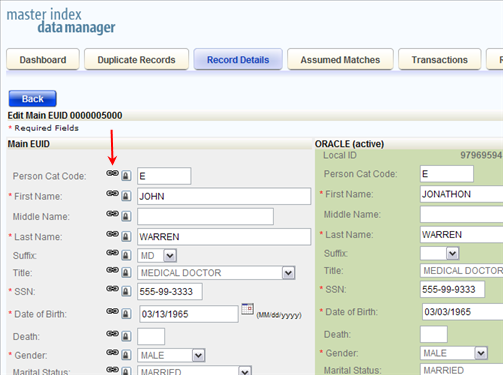
The icon is moved from the source record field to the SBR field that is no longer linked. The SBR is recalculated by the survivor calculator.
If an object has local IDs in addition to those already recorded in the master index application, you can add the local IDs to the object’s profile by adding a source record to the profile. To add a local ID to an object profile, you need to specify information such as the system that assigned the local ID, certain parent object information, and the local ID itself. When you add a source record to an object profile, the survivor calculator determines what changes, if any, should be made to the SBR.
You cannot add a new local ID and system pair to an object profile if that same local ID and system pair already exists in another object profile.
Figure 44 Record Details Page – Add Parent Information
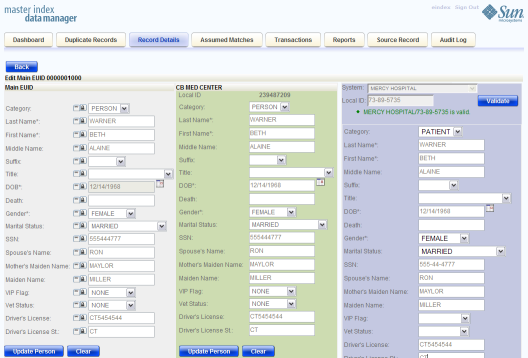
A new column appears to the right of the existing records for you to add the new source record.
If no existing record match the system and local ID you entered and the local ID is of a valid format, a message appears letting you know validation succeeded.
For example, to add an address record, select Add Addresses.
The page refreshes and the SBR is recalculated based on the new information.
Note - You only need to enter required fields in order to save the new source record. Required fields are indicated by an asterisk (*).
If an object profile or source record is no longer active, you cannot delete the profile or record, but you can deactivate it. Once you deactivate a record, you can reactivate it if needed. Deactivating an object profile removes the potential duplicate listings for that profile. If you deactivate a source record, the survivor calculator determines what changes, if any, should be made to the SBR.
Deactivated profiles cannot be modified, and in some cases, cannot be viewed. If you deactivate a profile in error, you can reactivate it if needed.
Figure 45 Record Details Page - Deactivate

The profile is deactivated in the database and the EUID appears in beige on the MIDM.
If an existing local ID for an object becomes obsolete, you can deactivate the source record with that local ID for the object profile. An object profile must have at least one active local ID; if you deactivate an object’s last active source record, the entire profile is deactivated. When you deactivate a source record from an object profile, the survivor calculator determines what changes, if any, should be made to the SBR.
You can deactivate a source record from the Record Details page, where you can view the source record within the context of its profile.
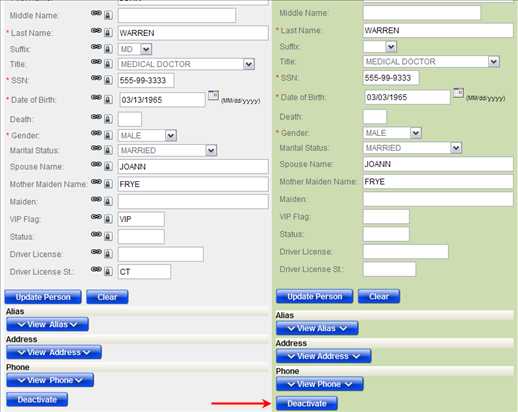
The page refreshes and the SBR for the object profile containing the source record is recalculated based on the new information.
Once an object profile or source record is deactivated, you can reactivate it if needed. Reactivating a profile causes the potential duplicates for the profile to be recalculated. Reactivating a source record causes the SBR to be recalculated.
If an object profile is deactivated in error or becomes active again, you can reactivate that profile. Reactivating a profile returns the profile to its status just prior to when it was deactivated.
Figure 46 Record Details Page - Reactivate
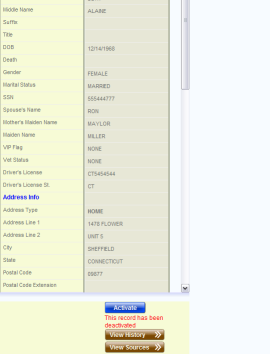
The profile is reactivated in the database.
If a source record was deactivated in error or is no longer inactive, you can easily reactivate the source record. You can activate the source record from the Record Details page, where you can view the source record within the context of its profile.

The page refreshes and the SBR for the object profile containing the source record is recalculated based on the new information.